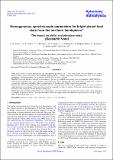Homogeneous spectroscopic parameters for bright planet host stars from the northern hemisphere. The impact on stellar and planetary mass
Abstract
Aims. In this work we derive new precise and homogeneous parameters for 37 stars with planets. For this purpose, we analyze high resolution spectra obtained by the NARVAL spectrograph for a sample composed of bright planet host stars in the northern hemisphere. The new parameters are included in the SWEET-Cat online catalogue. Methods. To ensure that the catalogue is homogeneous, we use our standard spectroscopic analysis procedure, ARES+MOOG, to derive effective temperatures, surface gravities, and metallicities. These spectroscopic stellar parameters are then used as input to compute the stellar mass and radius, which are fundamental for the derivation of the planetary mass and radius. Results. We show that the spectroscopic parameters, masses, and radii are generally in good agreement with the values available in online databases of exoplanets. There are some exceptions, especially for the evolved stars. These are analyzed in detail focusing on the effect of the stellar mass on the derived planetary mass. Conclusions. We conclude that the stellar mass estimations for giant stars should be managed with extreme caution when using them to compute the planetary masses. We report examples within this sample where the differences in planetary mass can be as high as 100% in the most extreme cases.
Citation
Sousa , S G , Santos , N C , Mortier , A , Tsantaki , M , Adibekyan , V , Delgado Mena , E , Israelian , G , Rojas-Ayala , B & Neves , V 2015 , ' Homogeneous spectroscopic parameters for bright planet host stars from the northern hemisphere. The impact on stellar and planetary mass ' , Astronomy & Astrophysics , vol. 576 , A94 . https://doi.org/10.1051/0004-6361/201425227
Publication
Astronomy & Astrophysics
Status
Peer reviewed
ISSN
0004-6361Type
Journal article
Description
This work is supported by the European Research Council/European Community under the FP7 through Starting Grant agreement number 239953. N.C.S. was supported by FCT through the Investigador FCT contract reference IF/00169/2012 and POPH/FSE (EC) by FEDER funding through the program Programa Operacional de Factores de Competitividade – COMPETE. S.G.S, E.D.M, and V.Zh.A. acknowledge the support from the Fundação para a Ciência e Tecnologia, FCT (Portugal) and POPH/FSE (EC), in the form of the fellowships SFRH/BPD/47611/2008, SFRH/BPD/76606/2011, and SFRH/BPD/70574/2010. A.M. acknowledges support from the European Union Seventh Framework Programme (FP7/2007-2013) under grant agreement number 313014 (ETAEARTH). G.I. acknowledges financial support from the Spanish Ministry project MINECO AYA2011-29060. V.N. acknowledges a CNPq/BJT Post-Doctorate fellowship 301186/2014-6 and partial financial support of the INCT INEspaço. The authors acknowledge support from OPTICON (EU-FP7 Grant number 312430).Collections
Items in the St Andrews Research Repository are protected by copyright, with all rights reserved, unless otherwise indicated.

